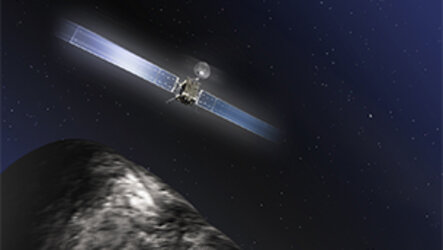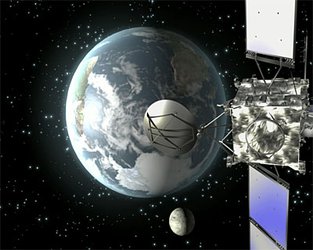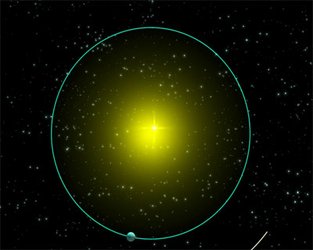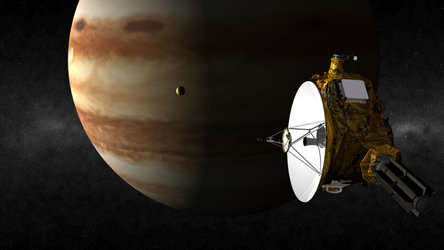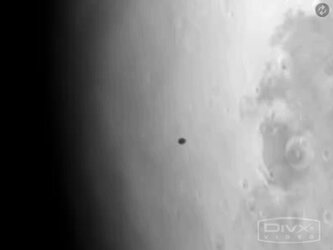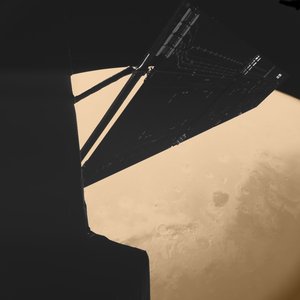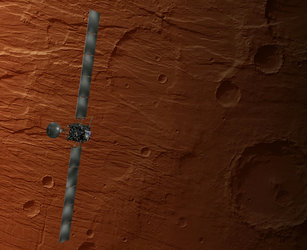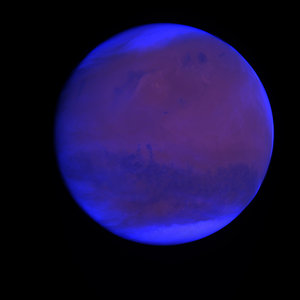Rosetta Earth swing-by two: Questions and Answers
Here we have prepared some expected questions and answers relating to Rosetta's second Earth swing-by.
The second Rosetta Earth Swing-by
Why does Rosetta need planetary swing-bys to reach its target comet 67P/Churyumov-Gerasimenko?
This is the only way to reach the comet 67P/Churyumov-Gerasimenko given the launch vehicle capabilities and the propulsion systems we have. This trajectory is not significantly different from what was initially planned to reach comet 46P/Wirtanen, the previous mission target.
To reach a rendezvous trajectory with the comet’s nucleus, the spacecraft must gain a lot of velocity. Swing-by manoeuvres are the only way to gain the required amount of energy. The swing-bys are necessary to accelerate the spacecraft so as to eventually match the velocity of the target comet. They are a way to save fuel while boosting speed using the gravity of a planet.
What are the key dates of the mission? How many swing-bys are foreseen during the journey? Which ones?
The key dates of the mission including planetary swing-bys are:
Launch: 2 March 2004
First Earth swing-by: 4 March 2005
Mars swing-by: 25 February 2007
Second Earth fly-by: 13 November 2007
Third Earth swing-by: 13 November 2009
Deep-space hibernation: May 2011 - January 2014
During its journey, Rosetta will cross the asteroid belt twice, and fly-by two asteroids: Asteroid Steins on 5 September 2008, and Asteroid Lutetia on 10 July 2010.
Comet approach: January-May 2014
Comet mapping / characterisation: August 2014
Release lander to land on the comet: November 2014
Escort the comet along its orbit around the Sun: November 2014 - December 2015
The mission ends in December 2015. Before that, Rosetta will again pass close to Earth’s orbit. This pass will occur more than 4000 days after the start of its adventure. It will then follow the comet until it reaches its perihelion, or point of closest approach to our star, in summer 2015, and accompany it for a few more months on the its path away from the Sun.
What is different this time around as compared to the previous Earth swing-by and Mars swing-by respectively?
Every swing-by manoeuvre has different approach and departure trajectories, depending on the needs of the mission. The first Earth swing-by imparted a significant change in the direction of the trajectory of Rosetta.
The Mars swing-by was designed such that the spacecraft could be routed in direction of the Earth for the second swing-by. During the Mars swing-by the spacecraft reduced its speed with respect to the Sun. During this second Earth swing-by the spacecraft will undergo significant acceleration with a relatively minor change in direction.
Every swing-by is also characterised by different geometrical conditions with respect to the planet and the Sun. The Mars swing-by was characterised by a Sun eclipse which forced the ground team to prepare the spacecraft for a unique event in the mission.
The second Earth swing-by is characterised by unfavourable relative geometry between the Sun, Earth and the spacecraft; raising the need to keep the spacecraft cool and making communicating with Earth a little tricky.
Is there any risk of crashing into Earth, or to bumping into one of the satellites currently in orbit around Earth?
Current trajectory calculations show that Rosetta is right on track, so there’s no such risk. Bumping into a satellite, or an interception in space is very difficult to achieve even intentionally.
Satellites are objects a few square metres in size moving at high velocities in orbits that are millions or even thousands of millions of cubic kilometres large. Despite this, to be sure, the Flight Dynamics team checks if Rosetta is on a collision course with any spacecraft in Earth orbit (which are all catalogued).
The risk of bumping into another spacecraft is therefore negligible.
What are the objectives of the swing-by?
During the swing-by, the highest priority will be given to spacecraft operations, as the manoeuvre is critical for the success of the overall mission.
Although the Earth-Moon system is not one of Rosetta’s scientific priorities, a few instruments both on the orbiter and the Philae lander will be activated for calibration, scientific measurements and imaging. Observations will take place for about two weeks around closest approach, from 7 Nov, h 01:00 CET, until 20 Nov, 15:00 CET.
At what time do you expect closest approach? At what distance and speed will Rosetta fly by Earth? What are the Earth coordinates of the swing-by?
The second Earth swing-by will take place on 13 November 2007. Closest approach is foreseen at 21:57 CET, at distance of 5301km from Earth’s surface, at 45000 km/h relative to Earth and 126 360 km/h relative to the Sun.
At closest approach, the Moon will be about 377 000km away from the spacecraft. Rosetta will be flying over Earth’s surface at 63° 46’ south, 74° 35’ west (16:17 local time) over the Pacific Ocean, south-west of Chile.
Can the spacecraft be observed from Earth with the naked eye or amateur telescopes?
Closest approach will take place over the middle of the Pacific ocean (south-west of Chile) during the day, so it is very unlikely that it will be spotted with the naked eye.
Have the final swing-by commands been sent to the spacecraft? If not, when will they be sent?
The final fly-by commands were uplinked on 1 November 2007. These included all the commands required for the spacecraft to safely go through the manoeuvre and the specific commands for science observations of the Earth-Moon system.
A software ‘patch’ necessary to command the OSIRIS instrument has been uplinked on 16 October 2006.
What if the spacecraft goes into safe mode before swing-by?
Depending on the technical reasons (and the way we understand it), it would take typically 12 to 20 hours to return Rosetta to nominal operation once in safe mode.
If the spacecraft goes into safe mode after the instruments observations have begun, then the science observations will be lost as there would be no time left to re-plan the activity. Nevertheless, the spacecraft would proceed safely on its trajectory towards Earth. There’s no risk of losing the spacecraft or the mission.
What if the spacecraft goes in safe mode during swing-by?
Since the swing-by is purely ballistic, the spacecraft can go through it while in safe mode. Only its capability to conduct science observations in the hours or days after the swing-by would be at risk.
Will there also be an eclipse period this time as during the Mars swing-by? How is the spacecraft equipped for such event? Would this cause any risk?
No, there is no such eclipse during this Earth swing-by. No further eclipses are foreseen throughout the rest of the mission.
How will we know Rosetta is in its right orbit after the swing-by?
The characteristics of the spacecraft’s orbit are determined through radiometric data, namely ranging and doppler shift measurements. This will be determined after the swing-by to make sure the characteristics are nominal. This is routine business as the orbit of the spacecraft is regularly determined.
What is the accuracy of our knowledge of Rosetta’s position?
The predicted swing-by trajectory is determined with an accuracy of about 3km. As the spacecraft closes in on Earth, the accuracy will improve to reach less than 1km.
What are the margins for Rosetta’s trajectory in terms of distance to Earth and relative velocity?
The target altitude for the swing-by is 5301 km. A Trajectory Correction Manoeuvre (TCM) will be performed in the last week only if it saves a significant amount of fuel for the rest of the mission. In any case, there is no risk in flying at a low altitude.
Will Rosetta interact with the upper atmosphere of Earth?
No, at those altitudes the atmospheric density is practically zero, so the interaction between Rosetta and Earth’s atmosphere can be completely neglected.
After this swing-by, Rosetta will swing by Earth again in 2009. Is there a risk that the second swing-by could send Rosetta on a collision course for the third one?
No - there are several Trajectory Correction Manoeuvres planned before the third Earth swing-by to put the spacecraft on the right trajectory.
Which ground stations will follow the swing-by? Are there backup stations available?
The prime site will be ESA’s New Norcia ground station in Australia. Additional support will be given by NASA’s Deep Space Network (DSN), providing continuous coverage to monitor the trajectory.
The second Rosetta Earth Swing-by – scientific output
Will any scientific measurements be undertaken during the swing-by? If so, which?
Around closest approach, some of the Rosetta instruments both on the orbiter and the lander will be activated for calibration and scientific measurements including imaging. The Earth and the Moon will be targeted during separate consecutive pointings for data on the surface, atmosphere and magnetosphere of Earth, and for data on the Moon.
Which instruments will be used?
The orbiter’s UV spectrometer (ALICE), plasma instrument package (RPC), the microwave experiment (MIRO), and the visual and infrared mapping spectrometer (VIRTIS) will be switched on for calibration in order to prepare for the asteroid and comet observations.
ALICE will obtain spectra of the illuminated Earth and Moon; ROMAP (the lander’s magnetometer) and RPC will perform measurements of Earth’s magnetosphere.
MIRO will test the asteroid mode sequence which is specially designed to make sure that the microwave radiation emitted by four volatile molecular species to be studied at Steins and Lutetia will be within its bandwidth (taking into account the doppler shift since the spacecraft is first approaching and then flying away from the target).
The Radio Science experiment will investigate possible anomalous acceleration during the swing-by. The radiation monitor experiment (SREM) will take measurements of Earth’s radiation belt.
VIRTIS will study fluorescent emission of carbon dioxide and molecular oxygen by scanning Earth’s atmosphere while pointing at Earth’s limb on the sunset side. VIRTIS will also obtain spectra of the Moon.
Last but not least, the orbiter’s camera (OSIRIS) will point to the Earth’s night side and image urban regions in Asia, Africa and Europe, look for shooting stars, image the Earth-Moon system from a distance and perform lunar disk spectro-photometry.
How are the observations planned? Are there any constraints to be taken into account?
On the incoming and outgoing trajectory of the swing-by, Rosetta will be under unfavourable solar illumination conditions, leading to thermal constrains for pointing and imaging. Only limited slots will be available for the instruments to be safely used.
Each observation by the instruments that require pointing will start at the end of a slew manoeuvre that will orient the spacecraft correctly. A few instruments (ROMAP, RPC, SREM and Radio Science) do not require the operation of pointing and therefore slews.
Around closest approach, imaging by Rosetta’s navigation camera is also foreseen, provided there is no interference with OSIRIS and VIRTIS observations.
Will live telemetry be available from Rosetta during the swing-by?
No. Unfortunately, the closest approach will occur in areas where the usable ground stations are not visible. Telemetry will be available for one hour before closest approach and will be resumed circa 30 minutes after closest approach.
How do the pictures get back to Earth and how long does it take?
The downlink of the first scientific data taken around the swing-by will start early in the morning of 14 November. However, it will take an hour during a downlink slot on 22 November to download all the scientific data packages.
To whom will the first pictures be forwarded and how will they be exploited?
All data from the instruments will be sent to the respective instrument teams, which will evaluate and process them first. The first images should be available to the public on the morning of 14 November.


